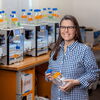New educational collaboration model gains steam
Ten years ago a group of Knox County business leaders, elected officials and economic development folks confronted the facts that we were losing our 18-to-34-year-olds, fell below the state average for per-capita income and that many in our aging work force had little or no education following high school.
Not a pretty picture.
Our employers, who already were struggling to find skilled employees, said they must have access to more well-trained, highly skilled technical workers if we are to survive as a region. But, being a very practical lot, our community leaders also knew that there was no bag of money with our name on it that would allow us to build and sustain the post-secondary technical education that we desperately needed.
Over the course of several years, leaders in the greater Knox County area designed a first-in-the-state regional governance structure that promotes the sharing of resources, programs and services among five school districts, a regional career-and-technical school, the University of Maine and the Maine Community College System. The new model is called Many Flags/One Community.
Its regional approach and collaborative governance structure caught the attention of the Obama administration: In partnership with Penquis Community Action Program, Many Flags/One Community was chosen as one of only 10 innovative models to receive a $348,000 U.S. Department of Education Promise Neighborhoods planning grant for 2013.
The planning grant will pay for a formal needs assessment, data collection and the development of strategies to tackle our region's problems. We'll be applying for implementation grant money in July. If we qualify, it would provide $6 million in annual funding for the next three to five years. Since only two or three Promise Neighborhood planning grants were awarded to innovative rural education systems like ours, we think we have a very good shot at the big grant.
It would be a game changer here … and a model for Maine. With the full grant funding, we can work on creating a comprehensive “Cradle to Career” regional education system.
In the meantime, our new regional governing board — launched in December — plans to tackle the following initiatives this year:
- Create common regional scheduling (no minor feat, given multiple school systems and districts are involved).
- Create common regional curriculum-mapping software and systems.
- Explore a regional “fifth year bridge program” (modeled after the Hermon High School pilot project, which allows students to earn up to 29.5 college credits during their junior and senior years and summer vacations and then complete associate degree programs in the year after graduation.)
- Explore common regional high school graduation standards and regional strategies to implement “standards-based” diplomas.
- Work with the private sector to design and implement at least two industry-specific training programs to fill local skills gaps — such as welding and the need for certified medical assistants.
With the competitive U.S. Department of Education planning grant in hand, we've gained credibility and hope it will lead to face-to-face meetings with major private foundations that might share our goals.
While I believe that it takes hard work, perseverance and tenacity to turn a vision into a reality, I've also become a believer in the moral of at least one fable. Sometimes slow and steady does win the race.
Alan Hinsey, executive director of the Many Flags Foundation, can be reached at alan@manyflags.org










0 Comments